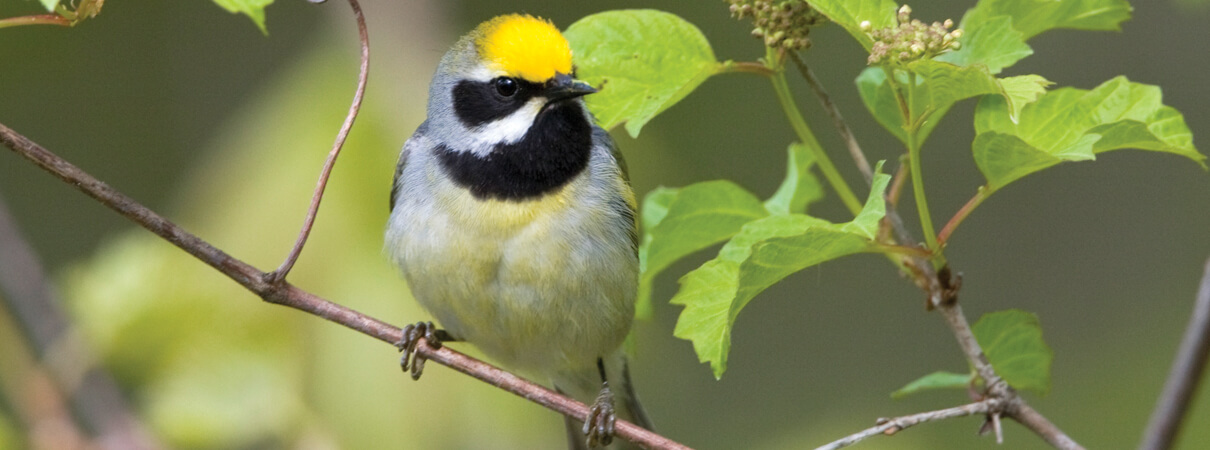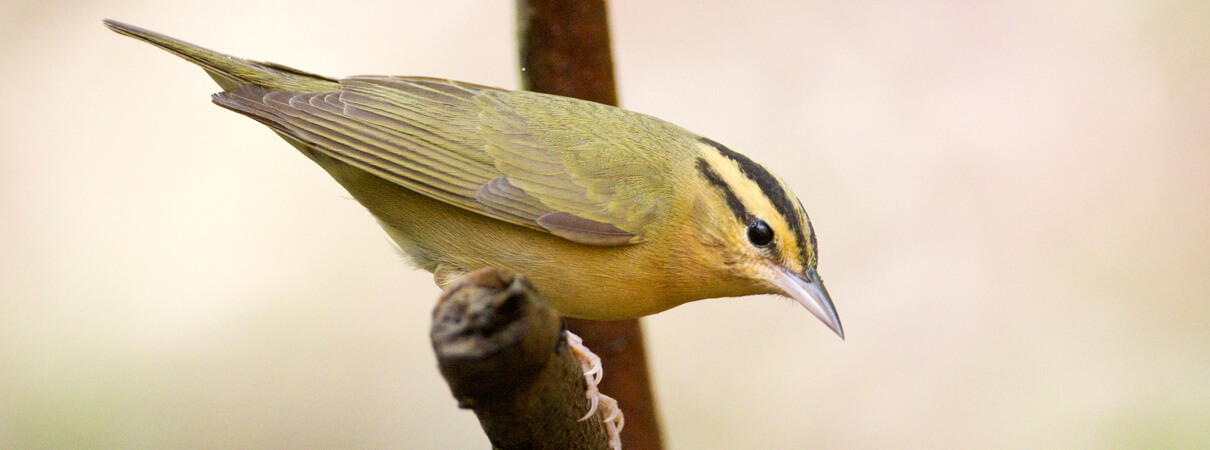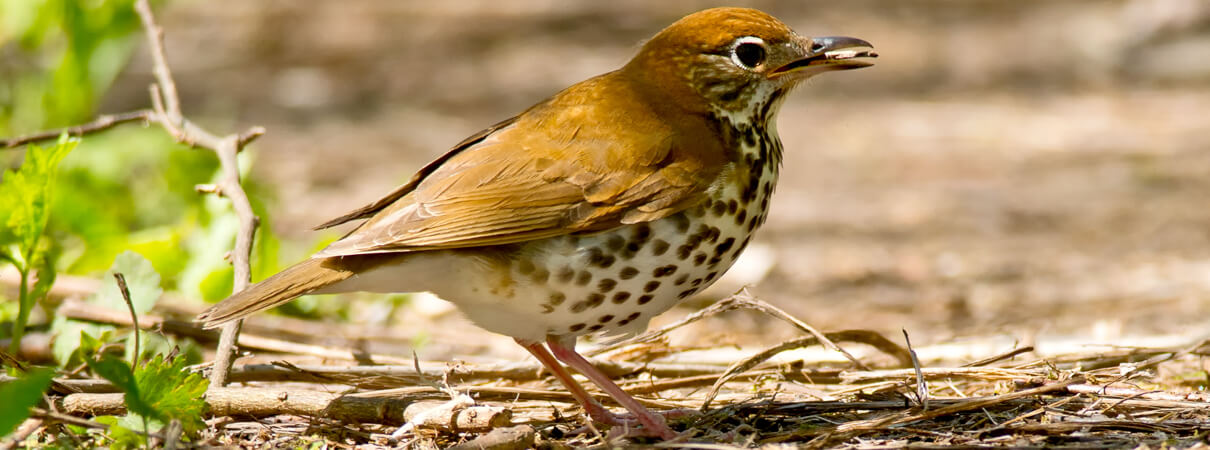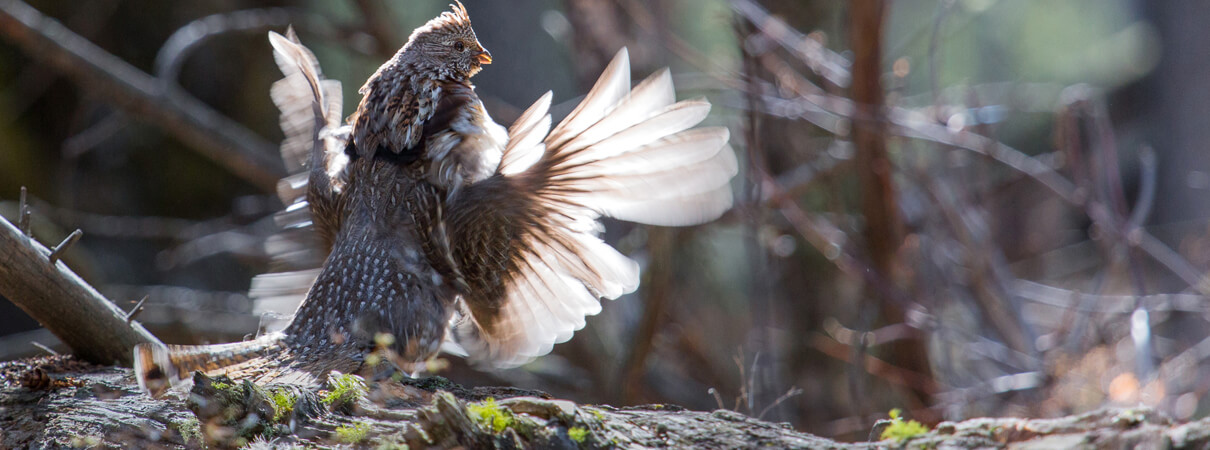In Appalachia, Landowners Create New Habitat for Forest Birds
Tom Kakabar has spent nearly all of his 51 years in southwestern Pennsylvania. But it wasn't until a decade ago that he realized the forests he'd hiked and hunted in for decades had changed from what he remembered as a boy.
It wasn't a happy revelation. Gray squirrels and chipmunks, once abundant, were gone. So, too, were the red oaks. Instead, the trees had become uniform: mostly striped maple, above a ground choked with hay-scented ferns.
“We've changed the forest,” he remembers thinking in 2004. “My goal is to try to get that back.”
So Kakabar, a third-generation member and president of the Beaverdale Sportsmen's Association, began to develop a stewardship plan for the club's 325-acre property near Johnstown. With incentives and insight from state and federal agencies, the club gradually began to manage its acreage differently.

Songbirds such as Golden-winged Warbler benefit from the diversity of young and mature forest at different stages of their lives. Photo by Glenn Bartley
In 2010, the club enrolled in a program run by the U.S. Department of Agriculture's Natural Resources Conservation Service to create 10 acres of habitat for a tiny black-bibbed songbird with a flash of yellow on its head and wing. Kakabar had never seen or heard a Golden-winged Warbler. Yet one acre at a time, he began improvements that have transformed his patch of forest into habitat for the elusive bird.
Foresters and biologists call this the dynamic forest: A sustainable approach to forest management that creates a mosaic of trees of different ages and species, which grow and change over time while preserving healthy habitat for forest birds and other wildlife. The approach is particularly helpful in Appalachia. There, imperiled songbirds such as the Golden-winged Warbler and the Cerulean Warbler benefit from the diversity of young and mature forest that both birds rely on at different stages of their lives.
As research into the behavior of Golden-winged Warblers and other songbirds becomes ever more sophisticated, biologists and foresters are starting to think more inclusively about how this kind of management might benefit an entire suite of declining birds. The concept holds significant potential in Appalachia, where a dynamic forest could stretch across a huge landscape—from northern Georgia to southern New York—attracting a large and diverse mix of warblers, tanagers, and flycatchers.
Private landowners like Tom Kakabar play a pivotal role in making it happen. Most land in the Appalachian region is privately owned. Much of it is broken down into small parcels—10 acres here, 50 acres there.
“What the bird needs is a diversity of age classes and forest structure in close proximity,” Daniel Rider, Forest Stewardship and Utilization Program Manager at the Maryland Forest Service, says of the golden-wing. “How are we going to get that? You need private landowners.”
A New Look at Golden-wings
For years, biologists studying Golden-winged Warblers had formed a picture of what kind of nesting habitat the bird needed. Concern was running high: The warbler's population had declined by 66 percent in the past 50 years, mostly because of habitat loss on its breeding grounds in the northeastern United States.
Scientists knew the birds nested in young forest and shrubs. Cerulean Warblers, meanwhile, raised their young in mature forests, preferring to be in the tallest trees. But research had long focused on a narrow window of time—a 30-day nesting season—and relied solely on what biologists could see and hear of the birds.

Scientists have recently discovered that Cerulean Warblers prefer structurally complex forests that offer many options. Photo by Tessa Nickels
Then they put transmitters on adult golden-wings and fledglings. The picture changed: Young forest, it turned out, was only part of the equation, says Jeff Larkin, a professor of wildlife ecology and conservation at Indiana University of Pennsylvania, who led the research.
Beyond the nesting period, none of the species studied—golden-wings and ceruleans, along with Wood Thrushes and Worm-eating Warblers— were faithful to a particular age class of trees. Instead, the data suggested that the birds preferred structurally complex forests that offered them many options.
Enter the dynamic forest. Biological research, along with innovative public-private partnerships, Larkin says, are aligning to promote a different way of viewing forests and their role in bird conservation.
“What is very clear is that we don't need to be thinking species-specific anymore,” Larkin says. If biologists, foresters, and landowners can work together to manage the land in a way that creates a structurally diverse forest, he says, “we're going to make a lot of progress in bird conservation in the years ahead.”
Creating a Forest Mosaic
Travel the spine of the Appalachians, and much of the landscape is a thick, unbroken carpet of trees. To the untrained eye, this dense forest appears healthy and robust. In fact, it is an unsustainable mix of trees that are the same age, and which reflect far less diversity than they could or should.
History tells part of the story. Most of the forests in Appalachia have been cut two, three, even four times. Aggressive timber harvests in the early 20th century, along with a drop-off in management over the past 50 years, means that an abundance of trees are all around the same age. White-tailed deer are now legion, eating seedlings and saplings and preventing the next generation of forest from taking root.

Deer can severely damage the forest understory. To the left of the fence, deer roam freely. The area to the right is protected from browsing deer, allowing a healthy forest understory to thrive. Photo by Isaac Betancourt
Meanwhile, the forest has become a rather uneventful place. Disturbances, natural and man-made, that spur healthy changes are minimal. Long ago, that was hardly the case: Herds of elk and bison trampled through, and from time to time Native Americans cleared and burned the wooded areas.
Foresters can't replicate conditions from centuries ago, says American Bird Conservancy's Todd Fearer, who leads the Appalachian Mountains Joint Venture, a regional partnership of more than a dozen organizations. But with intervention, he says, they can create a well-balanced forest.
For individual landowners, however, these changes can be costly. Several federal programs are designed to help them shoulder the costs of amending their land to improve conditions for wildlife, while making their forests more sustainable in the long run.
The Natural Resources Conservation Service's Working Lands for Wildlife is one such program. It provides financial support to landowners in 10 Appalachian states who agree to restore habitat for several declining species, including the Golden-winged Warbler. Now in its fifth year, the federal program has provided more than $4 million to landowners in Maryland, Pennsylvania, and New Jersey for golden-wing habitat. Of the 8,392 acres of habitat created so far, nearly 7,000 acres are in Pennsylvania.

Worm-eating Warbler is one of many forest birds that benefits from the "dynamic forest." Photo by Eleanor Briccetti
The program's success has sparked a similar undertaking for the Cerulean Warbler. Like the golden-wing, the bird has suffered steep declines since the 1960s. Seventy-five percent of cerulean distribution on the breeding grounds occurs on private land.
In early 2015, the NRCS Regional Conservation Partnership Program awarded $8 million to the Appalachian Mountains Joint Venture for a similar project to create habitat for the sky-blue birds in Kentucky, Ohio, Maryland, Pennsylvania, and West Virginia. ABC will manage the grant, and the Joint Venture will facilitate the work, collaborating with private landowners to create small gaps in the tree canopy by which ceruleans prefer to nest. In all, they hope to enhance 12,500 acres of forest habitat for Cerulean Warblers and other wildlife.
Both projects reflect a significant shift in how conservationists view the role of forest management.
Until recently, Fearer says, the prevailing philosophy held that management should target a few birds that used the same habitat. Many conservationists now embrace the idea that forests can, and should, change over time. Wood Thrush, Worm-eating Warblers, and other birds of the mature forest? They're part of the mosaic, too.
Fearer sums it up this way: “If you're going to manage for an entire suite of species, you have to manage in a dynamic fashion.”

Many conservationists now embrace the idea that forests can, and should, change over time, meeting the needs of a suite of species, including Wood Thrush. Photo by Paul Reeves Photography, Shutterstock
A New Landscape for Forest Birds
Emily Bellush spends most of her time talking and emailing with landowners in Pennsylvania, working to enroll them in NRCS's golden-wing program. They are intrigued by the project, says Bellush, who is a conservation biologist with Indiana University of Pennsylvania's Research Institute, and curious about the elusive warbler behind it.
The process works something like this. First, a forester meets with a landowner to take a look at the existing conditions and discuss the landowner's goals for his or her property. Ideally, the land would include a large expanse of forest composed of trees of different ages, and with young forest habitat nearby.
If the land looks promising, a conservation planner will coordinate the contractual arrangements between the landowner and NRCS, working closely with the landowner's consulting forester and logger.
Following a prescription from the forester, the logger harvests trees to shape the forest into an ideal mix of scattered trees, shrubs, and open, grassy spaces, paying careful attention to the abundance and spacing of trees. Bright paint marks the trees so the logger acts with the precision of a surgeon.

Ruffed Grouse is among the species that benefit from habitat managed for Golden-winged Warbler. Photo by Neal Herbert
The end result is a landscape deliberately designed to provide nesting habitat and food for Golden-winged Warblers—along with American Woodcock, Ruffed Grouse, and Eastern Whip-poor-will—for many years to come, even as the forest changes and matures.
In Pennsylvania, the average project creates about 50 acres of golden-wing breeding habitat, which Bellush says could support five pairs. From 2012 to 2015, Working Lands for Wildlife completed 83 projects in Pennsylvania and has 71 in progress. Several hundred more acres are under way in Maryland and New Jersey.
The Cerulean Warbler program, which is still in its infancy, could unfold on an even larger scale, says Rider, of the Maryland Forest Service. He says his agency hopes to be strategic in collaborating with landowners: Instead of creating a patch here and a patch there, why not look at public and private lands and make a block?
Everyone involved in the project is guided by a challenge, Rider says. “How can we create an entire landscape that is going to have long-term benefits to the bird?”
Building a Home for Golden-winged Warbler
Larkin and his team want to know whether they're winning the most important battle: recovering the golden-wing population.
Monitoring the thousands of acres adapted for golden-wing habitat will be critical, he says. 2015 was the first year biologists monitored lands enrolled in NRCS programs for golden-wings. In Appalachia, Larkin and his crew visited private lands in Pennsylvania, Maryland, and New Jersey to seek out migratory songbirds, with a focus on golden-wings, along with American Woodcock.

American Woodcock is another species that benefits from a dynamic approach to forest management. Photo by Mike Parr
Researchers detected the birds in 9 percent of the 150 points on private lands across the three states—low numbers, Larkin says, but about what he expected given the challenges the species faces in the region. And it's slow work: Two or three years typically pass before treated areas produce conditions that Golden-winged Warblers find attractive.
“We know that our Appalachian population is the one that's in the real crunch, and it's going to take a long time, and probably some innovative techniques, to recover the species in this area,” Larkin says.
“I look forward to the day when we have enough numbers in the Appalachians that every time we create habitat, we have a Golden-winged Warbler showing up.”
As for Tom Kakabar, all but 40 of his club's 325 acres are now managed according to guidance from state or federal programs. Bit by bit, the land is changing. Blackberries came back after treating the first 10 acres, along with red maple and black cherry trees. Chestnut-sided Warbler arrived after two seasons. This summer he's noticed wild orchids, trillium, and aspen.

Chestnut-sided Warbler. Photo by Trevor Jones, Shutterstock
On a sparkling Saturday afternoon last May, Kakabar got a phone call from one of Larkin's colleagues.
The team was coming to Beaverdale that evening to track woodcock. Kakabar rounded up his wife and two daughters, along with a few members of the club. At dusk, they trekked through briars and bramble that had grown up since the cutting of the trees, and waited in a clearing.
Spiraling up into the clear evening sky, then fluttering back down to earth, the woodcock performed their mating display for a rapt audience. Kakabar can count on one hand the number of times in his lifetime he'd seen the plump brown birds around the property. On this night, he felt like a proud father.
The golden-wings haven't shown up yet. But Kakabar has faith. I'm building them a nice home, he often thinks to himself. Now they just have to find it.
This article appeared in the fall 2015 edition of Bird Conservation magazine.
 Libby Sander is Senior Writer and Editor at American Bird Conservancy. As a journalist, she covered a variety of beats in Chicago and Washington, D.C., writing news stories and award-winning features for The New York Times, the Washington Post, and The Chronicle of Higher Education. You can follow her on Twitter at @libsander.
Libby Sander is Senior Writer and Editor at American Bird Conservancy. As a journalist, she covered a variety of beats in Chicago and Washington, D.C., writing news stories and award-winning features for The New York Times, the Washington Post, and The Chronicle of Higher Education. You can follow her on Twitter at @libsander.


















































